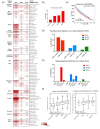MYC Deregulation in Primary Human Cancers
- PMID: 28587062
- PMCID: PMC5485515
- DOI: 10.3390/genes8060151
MYC Deregulation in Primary Human Cancers
Abstract
MYC regulates a complex biological program by transcriptionally activating and repressing its numerous target genes. As such, MYC is a master regulator of many processes, including cell cycle entry, ribosome biogenesis, and metabolism. In cancer, the activity of the MYC transcriptional network is frequently deregulated, contributing to the initiation and maintenance of disease. Deregulation often leads to constitutive overexpression of MYC, which can be achieved through gross genetic abnormalities, including copy number alterations, chromosomal translocations, increased enhancer activity, or through aberrant signal transduction leading to increased MYC transcription or increased MYC mRNA and protein stability. Herein, we summarize the frequency and modes of MYC deregulation and describe both well-established and more recent findings in a variety of cancer types. Notably, these studies have highlighted that with an increased appreciation for the basic mechanisms deregulating MYC in cancer, new therapeutic vulnerabilities can be discovered and potentially exploited for the inhibition of this potent oncogene in cancer.
Keywords: MYC; cancer; cell signaling; deregulation; enhancers; gene amplification; translocation.
Conflict of interest statement
The authors declare no conflict of interest.
Figures




Similar articles
-
N-Myc overexpression increases cisplatin resistance in neuroblastoma via deregulation of mitochondrial dynamics.Cell Death Discov. 2016 Dec 12;2:16082. doi: 10.1038/cddiscovery.2016.82. eCollection 2016. Cell Death Discov. 2016. PMID: 28028439 Free PMC article.
-
Extraosseous IL-6 transgenic mouse plasmacytoma sometimes lacks Myc-activating chromosomal translocation.Genes Chromosomes Cancer. 2005 Jun;43(2):137-46. doi: 10.1002/gcc.20172. Genes Chromosomes Cancer. 2005. PMID: 15751044
-
Variable IgH chain enhancer activity in Burkitt's lymphomas suggests an additional, direct mechanism of c-myc deregulation.J Immunol. 1993 Jun 15;150(12):5418-28. J Immunol. 1993. PMID: 8515068
-
MYC deregulation in lymphoid tumors: molecular mechanisms, clinical consequences and therapeutic implications.Biochim Biophys Acta. 2014 Dec;1846(2):457-67. doi: 10.1016/j.bbcan.2014.08.006. Epub 2014 Sep 6. Biochim Biophys Acta. 2014. PMID: 25199984 Review.
-
MYC-Master Regulator of the Cancer Epigenome and Transcriptome.Genes (Basel). 2017 May 13;8(5):142. doi: 10.3390/genes8050142. Genes (Basel). 2017. PMID: 28505071 Free PMC article. Review.
Cited by
-
Characterization of the Rat Osteosarcoma Cell Line UMR-106 by Long-Read Technologies Identifies a Large Block of Amplified Genes Associated with Human Disease.Genes (Basel). 2024 Sep 26;15(10):1254. doi: 10.3390/genes15101254. Genes (Basel). 2024. PMID: 39457378 Free PMC article.
-
Gene Transactivation and Transrepression in MYC-Driven Cancers.Int J Mol Sci. 2021 Mar 27;22(7):3458. doi: 10.3390/ijms22073458. Int J Mol Sci. 2021. PMID: 33801599 Free PMC article. Review.
-
Deregulation of enhancer structure, function, and dynamics in acute lymphoblastic leukemia.Trends Immunol. 2021 May;42(5):418-431. doi: 10.1016/j.it.2021.03.005. Epub 2021 Apr 12. Trends Immunol. 2021. PMID: 33858773 Free PMC article. Review.
-
Intricate crosstalk between MYC and non-coding RNAs regulates hallmarks of cancer.Mol Oncol. 2019 Jan;13(1):26-45. doi: 10.1002/1878-0261.12409. Epub 2018 Dec 5. Mol Oncol. 2019. PMID: 30451365 Free PMC article. Review.
-
Overexpressed c-Myc Sensitizes Cells to TH1579, a Mitotic Arrest and Oxidative DNA Damage Inducer.Biomolecules. 2022 Nov 29;12(12):1777. doi: 10.3390/biom12121777. Biomolecules. 2022. PMID: 36551206 Free PMC article.
References
-
- Mao D.Y., Watson J.D., Yan P.S., Barsyte-Lovejoy D., Khosravi F., Wong W.W., Farnham P.J., Huang T.H., Penn L.Z. Analysis of MYC bound loci identified by CpG island arrays shows that MAX is essential for MYC-dependent repression. Curr. Biol. 2003;13:882–886. doi: 10.1016/S0960-9822(03)00297-5. - DOI - PubMed
-
- Mateyak M.K., Obaya A.J., Adachi S., Sedivy J.M. Phenotypes of c-MYC-deficient rat fibroblasts isolated by targeted homologous recombination. Cell Growth Differ. 1997;8:1039–1048. - PubMed
Publication types
LinkOut - more resources
Full Text Sources
Other Literature Sources
Research Materials

